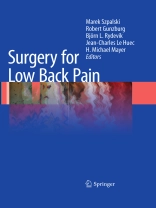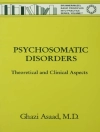Low back pain is a very common problem that is increasingly being treated surgically. This book aims to evaluate carefully the possible surgical approaches to low back pain, with detailed appraisal of the factors leading to their success or failure. It begins by explaining the scientific basis for surgery and considering the different diagnostic techniques that may be employed, thereby elucidating the surgical rationale, indications, and contraindications. The value of conservative options is also assessed to help the reader weigh the need for surgery. The various surgical modalities, including the most recent, are then fully described and evaluated with the aid of numerous illustrations. The book concludes with a chapter devoted to evidence-based analysis of the outcome of surgery in patients with low back pain. This book will be invaluable to orthopaedic and neurosurgeons, rheumatologists, neurologists, and all who are concerned with the effective treatment of this often debilitating condition.
Mục lục
Basics.- The Biology of Intervertebral Disc Degeneration.- Low Back Pain: Where Does the Pain Come From?.- The Role of Cytokines in the Degenerative Spine.- Psychosocial Aspects of Low Back Pain.- Instability and Low Back Pain.- Diagnosis.- Dynamic MRI of the Spine.- Assessment of Status of End Plate and Diffusion in Degenerative Disc Disease.- The Role of Physician Extenders in a Low Back Pain Practice.- Conservative Treatment.- Natural Evolution of Nonspecific Low-Back Pain.- Prescribing Conservative Treatment for Low Back Pain.- Comprehensive Rehabilitation for Low back Pain and Back Schools.- The Place of Chiropractic Care in the Treatment of Low Back Pain.- Efficacy of IDET and PIRFT for the Treatment of Discogenic Low Back Pain.- Lumbar Orthoses to Prevent and Treat Low-Back Pain.- Surgical Treatment: Fusion.- Indication for Lumbar Spinal Fusion.- Evidence for Efficacy of Pedicle-Based Systems.- Low Back Pain Is Not an Indication for Stabilisation in Patients Operated for Lumbar Spinal Stenosis.- Hybrid Construct for DDD in the Lumbar Spine: The Compromise Between Fusion and Nonfusion.- The Management of Spondylolysis and Spondylolisthesis.- Transpedicular-Transdiscal-Transcorporal (TPDC)-Fixation.- Facet Problems: A Surgical Indication?.- “Myth” or “Fact”.- Pelvic Girdle Pain: Indication for Surgery?.- Blood Loss Management in Major Spine Surgery.- Surgical Treatment: Other Technologies.- How Disc Replacement Fits in the Treatment Algorithm for Degenerative Disc Disease: Refining Indications for Disc Replacement.- Clinical Factors that May Affect Outcome in Lumbar Total Disc Replacement. What Is the Evidence?.- A Prospective Randomized Comparison of Two Lumbar Total Disk Replacements.- Limitations of Lumbar Disk Arthroplasty.- Is Posterior Dynamic Stabilization an Option to Avoid Adjacent Segment Decompensation?.- Immediate Biomechanical Effects of Lumbar Posterior Dynamic Stabilisation.- Overview of Pedicle Screw-Based Posterior Dynamic Stabilization Systems.- Semirigid Fixation System for the Lumbar Spine.- Nonrigid Stabilization of the Spine – Problems Observed: Screw Loosening/Breakage/Implant Failure/Adjacent Segment Degeneration.- Interspinous Implants: State of the Art and Research of Evidence.- Nu Bac Disc Arthroplasty System: Rationale and Clinical Results.- Outcomes.- Outcome Assessment for Cost-Utility Evaluations: SF-6D vs. EQ-5D.- Review of the Medical Evidence Regarding the Surgical Treatment of Low Back Pain.












